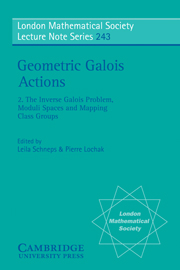Book contents
- Frontmatter
- Contents
- Introduction
- Abstracts
- Part I Dessins d'enfants
- Unicellular cartography and Galois orbits of plane trees
- Galois groups, monodromy groups and cartographic groups
- Permutation techniques for coset representations of modular subgroups
- Dessins d'enfants en genre 1
- Part II Inverse Galois problem
- Part III Galois actions, braids and mapping class groups
- Part IV Universal Teichmüller theory
- Errata for Tame and stratified objects
Unicellular cartography and Galois orbits of plane trees
Published online by Cambridge University Press: 04 May 2010
- Frontmatter
- Contents
- Introduction
- Abstracts
- Part I Dessins d'enfants
- Unicellular cartography and Galois orbits of plane trees
- Galois groups, monodromy groups and cartographic groups
- Permutation techniques for coset representations of modular subgroups
- Dessins d'enfants en genre 1
- Part II Inverse Galois problem
- Part III Galois actions, braids and mapping class groups
- Part IV Universal Teichmüller theory
- Errata for Tame and stratified objects
Summary
Introduction
After several years of extensive research in the directions outlined byAlexander Grothendieck in his Esquisse d'un Programme [Gr], there stillexists a considerable gap between what we are able to calculate (Belyi pairs,fields of moduli, etc.) and what we are able to see (the combinatorial topology of dessins d'enfants). In this situation it is important to find the visualizable Galois invariants of dessins.
Several versions of finite groups of substitutions associated to dessins deliver some of such invariants. They are known as cartographic groups, monodromy groups, etc.; we use the term group of edge rotations. Their Galois invariance is established in [Mat], [JS].
Edge rotation groups do not completely solve the problem of determining the Galois orbits of dessins d'enfants. For example, they do not separate the trees from the orbit of Leila's flower [Sch2]. However, the non–trivial behavior of edge rotations points out certain interesting phenomena.
One of the goals of the present paper is to draw attention to a class of dessins which seems to occupy a reasonable intermediate position between general dessins and plane trees. This is the class of unicellular dessins (them aps with only one face). Theorem 1.1 shows that this case is not restrictive from the point of view of moduli of curves.
Theorem 2.1 describes the composition factors of unicellular dessins. In section 2.2 we present a complete list of primitive edge rotation groups in the genus zero case. In part 3 we show the techniques of calculations of edge rotation groups with “bare hands”.
- Type
- Chapter
- Information
- Geometric Galois Actions , pp. 13 - 24Publisher: Cambridge University PressPrint publication year: 1997
- 1
- Cited by



